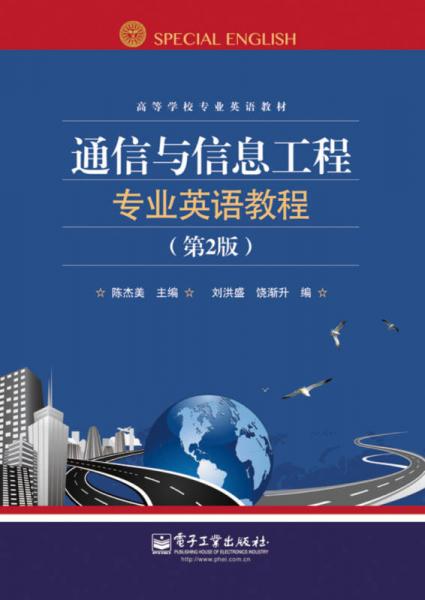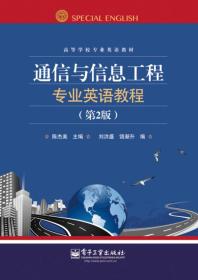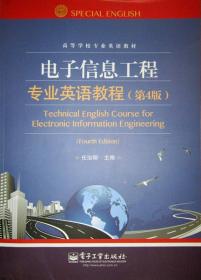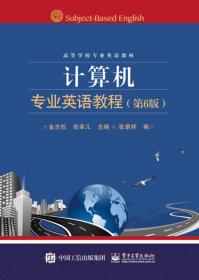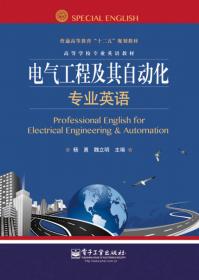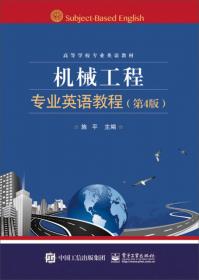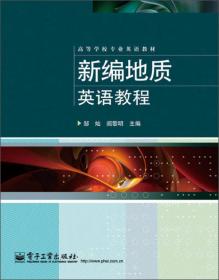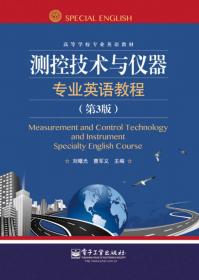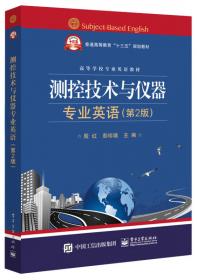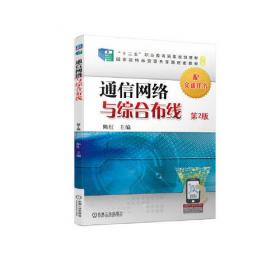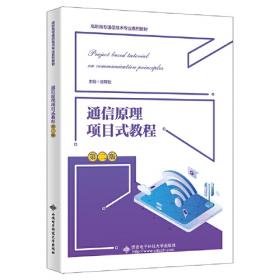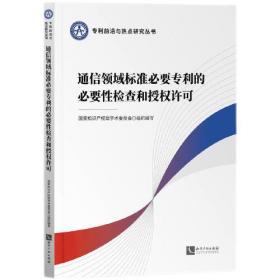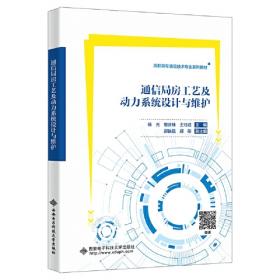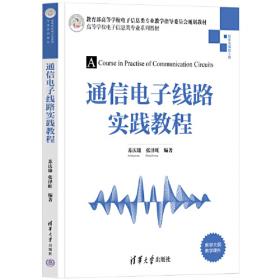通信与信息工程专业英语教程(第2版)
出版时间:
2014-04
版次:
2
ISBN:
9787121227769
定价:
39.00
装帧:
平装
开本:
16开
纸张:
胶版纸
页数:
308页
正文语种:
简体中文
29人买过
-
《通信与信息工程专业英语教程(第2版)》旨在培养和提高学生在通信专业方面的英语阅读、笔译能力,同时也有助于培养英语专业文章的写作能力和对专业问题的口头表达能力。本书简要介绍科技英语的基本知识和特点。本书课文精选自国外知名大学的通信工程教科书,涵盖现代电子通信的各个领域,系统性强,且行文流畅。各课皆附有生词表、难点注释和练习题。书后附有参考译文和参考文献。为方便教学,本书另配有电子教案和练习题参考答案,向采纳本书作为教材的教师免费提供。 陈杰美,电子科技大学教授。获得的学术与教学奖励: 1979年获电子部科技一等奖;1987年获全国优秀工科教材二等奖; 1981年因主持“相位噪声分析仪“获得电子部科技一等奖;1987年因主编《电子测量仪器原理》获得全国电子类优秀教材一等奖。出版的教材与学术专著:电子测量仪器原理(上、下)、电子仪器、信号与系统、噪声中的测量、通信与信息工程专业英语 Lesson 0 科技英语的基础知识
0.1 科技英语中的几个关键问题
(Some Key Problems in Scientific and Technical English)
0.1.1 词汇(Vocabularies or Words)
0.1.2 虚义词(Form Words)
0.1.3 长句(Long Sentences)
0.2 翻译的准则(Criteria of Translation)
0.3 翻译中的变换(Changes in Translation)
0.3.1 词类的变换(Changes Between Word Classes)
0.3.2 词序的变换(Changes in Word Order)
0.3.3 省略(Ellipsis)
0.3.4 补充(Supplements)
0.3.5 引申(Extensions)
0.4 关于数量(Numbers and Quantities)
0.4.1 数制(Number Systems)
0.4.2 量词的缩写(Abbreviations about Numbers)
0.4.3 关于数量的增减(About Increase and Decrease)
0.5 数学符号与数学式(Mathematic Symbols and Expressions)
0.5.1 常用数学符号(Mathematic Symbols)
0.5.2 常用希腊字母(Grecian Letters)
0.5.3 常用数学式(Mathematic Expressions)
0.6 论文标题与摘要的写作(How to Write a Thesis)
0.6.1 论文标题(How to Write the Title)
0.6.2 论文摘要(How to Write the Abstract)
0.6.3 论文摘要的常用句型(Some Useful Patterns Used in the Abstract)
0.6.4 例子(Examples)
Lesson 1 Introduction to Electronic Communications
1.1 Historical Perspective
1.2 Electronic Communications Systems
1.3 The Electromagnetic Spectrum
1.4 Bandwidth and Information Capacity
Reading Material
Lesson 2 Information Sources
2.1 Speech and Music
2.2 Pictures
2.3 Computer Data
2.4 Noise
Reading Material
Lesson 3 Information Systems
3.1 Information and Data
3.2 Information System
3.3 Computer?based Information System
3.4 Business Information Systems
Reading Material
Lesson 4 Signal Generation
4.1 LC Circuits
4.2 Oscillators
4.3 Integrated?Circuit Waveform Generation
4.4 Digital Waveform Generation
Reading Material
Lesson 5 Random Processes
5.1 Introduction
5.2 Mathematical Definition of a Random Process
5.3 Stationary Process
5.4 Mean, Correlation, and Covariance Functions
5.5 Ergodic Processes
5.6 Gaussian Process
Reading Material
Lesson 6 Amplitude Modulation Transmission
6.1 Principles of Amplitude Modulation
6.2 Single?side Band Modulation
6.3 Generation of SSB Waves
6.4 Weaver SSB frequency shifting technique
Reading Material
Lesson 7 Angle Modulation
7.1 Representation of PM and FM Signals
7.2 Spectra of Angle?Modulated Signals
7.3 Narrowband Angle Modulation
7.4 Wideband Frequency Modulation
7.5 Preemphasis and Deemphasis in Angle?Modulated Systems
Reading Material
Lesson 8 Video Communications
8.1 Overview of Video communication
8.2 Typical Video applications
8.3 Communication Networks
Reading Material
Lesson 9 Transmission Lines
9.1 Types of Transmission Lines
9.2 Transmission?line Wave Propagation
9.3 Time?domain Reflectometry
Reading Material
Lesson 10 Electromagnetic Wave Propagation
10.1 Introduction
10.2 Optical Properties of Radio Waves
10.3 Terrestrial Propagation of Electromagnetic Waves
Reading Material
Lesson 11 Antennas and Waveguides
11.1 Introduction
11.2 Antenna Terminology and Definitions
11.3 Antenna Arrays and Array Antenna[14]
11.4 Waveguides
Reading Material
Lesson 12 Optical fiber communications
12.1 Fibers in communications
12.2 Fiber?Optic Communication Equipment
12.3 Transmitter?s Operational Considerations
12.4 WDM Systems
Reading Material
Lesson 13 Digital Modulation
13.1 Introduction
13.2 Factors That Influence the Choice of Digital Modulation
13.3 Binary Modulated Bandpass Signaling
13.4 Multilevel Modulated Bandpass Signaling
Reading Material
Lesson 14 Data Communications, Codes Error Control
14.1 Introduction
14.2 Data Communications Circuits
14.3 Data Communications Codes
14.4 Error Control
Reading Material
Lesson 15 Communication Networks
15.1 Telephone Networks
15.2 Computer Networks
15.3 Cable Television Networks
15.4 Wireless Networks
Reading Material
Lesson 16 Software Radio
16.1 Introduction
16.2 Characters of a Software Radio
16.3 The RF Front?End
16.4 Smart Antennas
16.5 Digital Generation of Signals
Reading Material
Lesson 17 Microwave Radio Communications
17.1 Introduction
17.2 Frequency?Modulated Microwave Radio System
17.3 Digital Radio Systems
Reading Material
Lesson 18 Satellite Communication Systems
18.1 Introduction
18.2 Design of the Satellite Link
18.3 Network Architecture
18.4 Geostationary Satellite Systems
Reading Material
Lesson 19 Multiple Accessing
19.1 Introduction
19.2 Frequency Division Multiple Access
19.3 Time Division Multiple Access and ALOHA
19.4 Code Division Multiple Access
Reading Material
Lesson 20 Mobile Telephone Service
20.1 Introduction
20.2 Basic Cellular Telephone Concepts
20.3 Digital Cellular Telephone
20.4 Code division Multiple Accessing
Reading Material
参考译文
参考文献
-
内容简介:
《通信与信息工程专业英语教程(第2版)》旨在培养和提高学生在通信专业方面的英语阅读、笔译能力,同时也有助于培养英语专业文章的写作能力和对专业问题的口头表达能力。本书简要介绍科技英语的基本知识和特点。本书课文精选自国外知名大学的通信工程教科书,涵盖现代电子通信的各个领域,系统性强,且行文流畅。各课皆附有生词表、难点注释和练习题。书后附有参考译文和参考文献。为方便教学,本书另配有电子教案和练习题参考答案,向采纳本书作为教材的教师免费提供。
-
作者简介:
陈杰美,电子科技大学教授。获得的学术与教学奖励: 1979年获电子部科技一等奖;1987年获全国优秀工科教材二等奖; 1981年因主持“相位噪声分析仪“获得电子部科技一等奖;1987年因主编《电子测量仪器原理》获得全国电子类优秀教材一等奖。出版的教材与学术专著:电子测量仪器原理(上、下)、电子仪器、信号与系统、噪声中的测量、通信与信息工程专业英语
-
目录:
Lesson 0 科技英语的基础知识
0.1 科技英语中的几个关键问题
(Some Key Problems in Scientific and Technical English)
0.1.1 词汇(Vocabularies or Words)
0.1.2 虚义词(Form Words)
0.1.3 长句(Long Sentences)
0.2 翻译的准则(Criteria of Translation)
0.3 翻译中的变换(Changes in Translation)
0.3.1 词类的变换(Changes Between Word Classes)
0.3.2 词序的变换(Changes in Word Order)
0.3.3 省略(Ellipsis)
0.3.4 补充(Supplements)
0.3.5 引申(Extensions)
0.4 关于数量(Numbers and Quantities)
0.4.1 数制(Number Systems)
0.4.2 量词的缩写(Abbreviations about Numbers)
0.4.3 关于数量的增减(About Increase and Decrease)
0.5 数学符号与数学式(Mathematic Symbols and Expressions)
0.5.1 常用数学符号(Mathematic Symbols)
0.5.2 常用希腊字母(Grecian Letters)
0.5.3 常用数学式(Mathematic Expressions)
0.6 论文标题与摘要的写作(How to Write a Thesis)
0.6.1 论文标题(How to Write the Title)
0.6.2 论文摘要(How to Write the Abstract)
0.6.3 论文摘要的常用句型(Some Useful Patterns Used in the Abstract)
0.6.4 例子(Examples)
Lesson 1 Introduction to Electronic Communications
1.1 Historical Perspective
1.2 Electronic Communications Systems
1.3 The Electromagnetic Spectrum
1.4 Bandwidth and Information Capacity
Reading Material
Lesson 2 Information Sources
2.1 Speech and Music
2.2 Pictures
2.3 Computer Data
2.4 Noise
Reading Material
Lesson 3 Information Systems
3.1 Information and Data
3.2 Information System
3.3 Computer?based Information System
3.4 Business Information Systems
Reading Material
Lesson 4 Signal Generation
4.1 LC Circuits
4.2 Oscillators
4.3 Integrated?Circuit Waveform Generation
4.4 Digital Waveform Generation
Reading Material
Lesson 5 Random Processes
5.1 Introduction
5.2 Mathematical Definition of a Random Process
5.3 Stationary Process
5.4 Mean, Correlation, and Covariance Functions
5.5 Ergodic Processes
5.6 Gaussian Process
Reading Material
Lesson 6 Amplitude Modulation Transmission
6.1 Principles of Amplitude Modulation
6.2 Single?side Band Modulation
6.3 Generation of SSB Waves
6.4 Weaver SSB frequency shifting technique
Reading Material
Lesson 7 Angle Modulation
7.1 Representation of PM and FM Signals
7.2 Spectra of Angle?Modulated Signals
7.3 Narrowband Angle Modulation
7.4 Wideband Frequency Modulation
7.5 Preemphasis and Deemphasis in Angle?Modulated Systems
Reading Material
Lesson 8 Video Communications
8.1 Overview of Video communication
8.2 Typical Video applications
8.3 Communication Networks
Reading Material
Lesson 9 Transmission Lines
9.1 Types of Transmission Lines
9.2 Transmission?line Wave Propagation
9.3 Time?domain Reflectometry
Reading Material
Lesson 10 Electromagnetic Wave Propagation
10.1 Introduction
10.2 Optical Properties of Radio Waves
10.3 Terrestrial Propagation of Electromagnetic Waves
Reading Material
Lesson 11 Antennas and Waveguides
11.1 Introduction
11.2 Antenna Terminology and Definitions
11.3 Antenna Arrays and Array Antenna[14]
11.4 Waveguides
Reading Material
Lesson 12 Optical fiber communications
12.1 Fibers in communications
12.2 Fiber?Optic Communication Equipment
12.3 Transmitter?s Operational Considerations
12.4 WDM Systems
Reading Material
Lesson 13 Digital Modulation
13.1 Introduction
13.2 Factors That Influence the Choice of Digital Modulation
13.3 Binary Modulated Bandpass Signaling
13.4 Multilevel Modulated Bandpass Signaling
Reading Material
Lesson 14 Data Communications, Codes Error Control
14.1 Introduction
14.2 Data Communications Circuits
14.3 Data Communications Codes
14.4 Error Control
Reading Material
Lesson 15 Communication Networks
15.1 Telephone Networks
15.2 Computer Networks
15.3 Cable Television Networks
15.4 Wireless Networks
Reading Material
Lesson 16 Software Radio
16.1 Introduction
16.2 Characters of a Software Radio
16.3 The RF Front?End
16.4 Smart Antennas
16.5 Digital Generation of Signals
Reading Material
Lesson 17 Microwave Radio Communications
17.1 Introduction
17.2 Frequency?Modulated Microwave Radio System
17.3 Digital Radio Systems
Reading Material
Lesson 18 Satellite Communication Systems
18.1 Introduction
18.2 Design of the Satellite Link
18.3 Network Architecture
18.4 Geostationary Satellite Systems
Reading Material
Lesson 19 Multiple Accessing
19.1 Introduction
19.2 Frequency Division Multiple Access
19.3 Time Division Multiple Access and ALOHA
19.4 Code Division Multiple Access
Reading Material
Lesson 20 Mobile Telephone Service
20.1 Introduction
20.2 Basic Cellular Telephone Concepts
20.3 Digital Cellular Telephone
20.4 Code division Multiple Accessing
Reading Material
参考译文
参考文献
查看详情
-
全新
北京市海淀区
平均发货18小时
成功完成率88.79%
-
全新
山东省烟台市
平均发货15小时
成功完成率93.59%
-
全新
北京市朝阳区
平均发货11小时
成功完成率96.32%
-
九品
北京市东城区
平均发货25小时
成功完成率89.43%
-
八五品
重庆市沙坪坝区
平均发货9小时
成功完成率90.59%
-
八五品
重庆市沙坪坝区
平均发货9小时
成功完成率90.59%
-
全新
湖南省长沙市
平均发货33小时
成功完成率85.6%
-
全新
北京市朝阳区
平均发货12小时
成功完成率96.77%
-
全新
江苏省南京市
平均发货6小时
成功完成率96.52%
-
全新
浙江省嘉兴市
平均发货13小时
成功完成率94.89%
-
全新
广东省广州市
平均发货7小时
成功完成率93.75%
-
八五品
山东省滨州市
平均发货9小时
成功完成率93.85%
-
 11
11
八五品
重庆市沙坪坝区
平均发货8小时
成功完成率84.31%
-
八五品
山东省枣庄市
平均发货9小时
成功完成率87.86%
-
八五品
山东省济南市
平均发货8小时
成功完成率94.37%
-
九五品
江西省南昌市
平均发货10小时
成功完成率94.49%
-
九品
江西省南昌市
平均发货10小时
成功完成率93.28%
-
全新
江苏省南京市
平均发货5小时
成功完成率98.34%
-
九品
北京市昌平区
平均发货23小时
成功完成率88.61%
-
八五品
广西南宁市
平均发货8小时
成功完成率89.64%
-
八五品
广西南宁市
平均发货8小时
成功完成率88.69%
-
全新
广东省广州市
平均发货17小时
成功完成率94.77%
-
全新
广东省广州市
平均发货17小时
成功完成率93.25%
-
全新
广东省广州市
平均发货16小时
成功完成率92.31%
-
全新
-
全新
江苏省南京市
平均发货5小时
成功完成率98.4%
-
全新
四川省成都市
平均发货22小时
成功完成率91.19%
-
全新
北京市海淀区
平均发货16小时
成功完成率88.43%
-
 5
5
全新
北京市丰台区
平均发货29小时
成功完成率85.9%
-
全新
北京市通州区
平均发货9小时
成功完成率94.33%
-
全新
北京市房山区
平均发货12小时
成功完成率95.88%
-
八五品
四川省成都市
平均发货8小时
成功完成率93.64%
-
八五品
湖北省咸宁市
平均发货11小时
成功完成率91.26%
-
全新
北京市西城区
平均发货16小时
成功完成率92.03%
-
全新
浙江省嘉兴市
平均发货9小时
成功完成率95.54%
-
 3
3
八五品
河北省衡水市
平均发货5小时
成功完成率96.79%
-
九品
北京市通州区
平均发货8小时
成功完成率93.37%
-
八五品
山东省济南市
平均发货12小时
成功完成率93.43%
-
八五品
山东省滨州市
平均发货8小时
成功完成率88.47%
-
八五品
湖北省咸宁市
平均发货12小时
成功完成率94.35%
-
八五品
山东省滨州市
平均发货9小时
成功完成率90.58%
-
八五品
上海市黄浦区
平均发货8小时
成功完成率89.03%
-
八五品
福建省福州市
平均发货5小时
成功完成率94.06%
-
全新
北京市通州区
平均发货9小时
成功完成率89.53%
-
八五品
浙江省杭州市
平均发货8小时
成功完成率94.35%
-
八五品
江苏省南京市
平均发货13小时
成功完成率87.69%
-
九品
北京市通州区
平均发货8小时
成功完成率92.86%
-
全新
江苏省南京市
平均发货14小时
成功完成率83.66%
-
八五品
甘肃省兰州市
平均发货10小时
成功完成率92.46%
-
九五品
北京市通州区
平均发货31小时
成功完成率82.75%

 占位居中
占位居中

